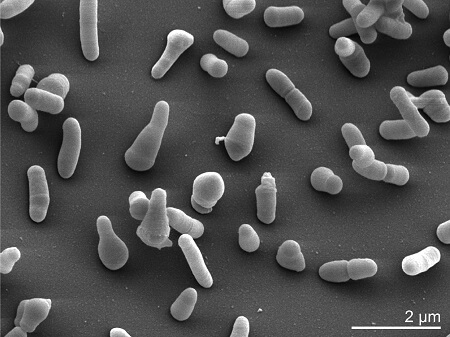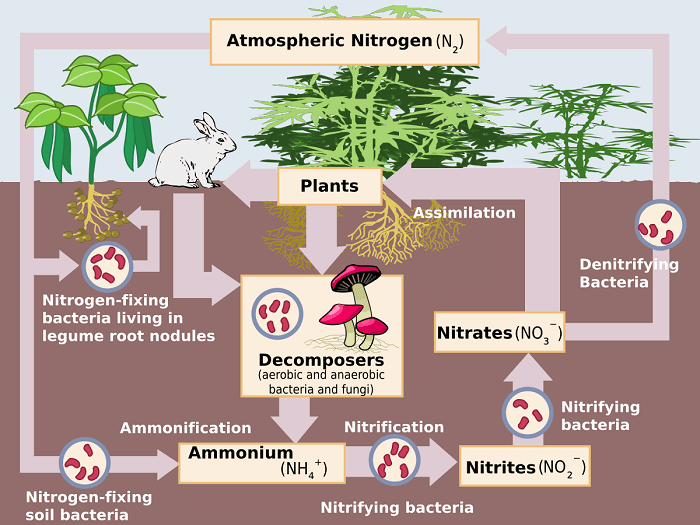Denitrifying BacteriaGenerally, denitrification is a process of removal of nitrates or nitrites present in the soil, and water air by chemical reaction. Denitrification is a crucial step in Nitrogen Fixation which involves the conversion of nitrates in the soil to atmospheric nitrogen. The process of denitrification was carried out by the denitrifying bacteria such as Thiobacillus denitrificans, Micrococcus, and some species of Pseudomonas, Serratia, and Achromobacter. 
Denitrification in the absence of oxygen (anaerobic condition) is carried out by the denitrifier bacterial species of Pseudomonas aeruginosa. An anaerobic condition where denitrification by Pseudomonas aeruginosa occurs in swampy or waterlogged soils. This reduces the fixed nitrogen content by 50% in the atmosphere. Examples of Nitrifying and Denitrifying bacteria are followsNitrosomonas, Nitrosococcus, Nitrosolobus, and Nitrosospira are the major bacteria that carry out the process of Nitrification. Pseudomonas, Thiobacillus denitrificans, Serratia, Achromobacter, and Micrococcus denitrificans are some major examples of the Denitrification process. DenitrificationThe denitrifying bacteria reduces the nitrate molecule to nitrous oxide and nitrogen molecule. The intermediate in the reaction also acts as an anaerobic electron acceptor. (valency) NO3- (+5) → NO2- (+3) + NO (+2) + N2O (+1) + N2 (0) Nitrate Nitrite. Nitric Oxide. Nitrous oxide. Dinitrogen Here, the denitrification step from the conversion of nitrate to nitrogen molecule requires four-electron transport pathways. This step requires enzymes such as nitrate reductase, nitrite reductase, nitric oxide reductase, and nitrous oxide reductase. Most denitrifiers also use aerobic respiration to produce energy but the aerobic respiration process and denitrification are normally different because of the distinction in metabolic regulation. Thus, in the aerobic state (presence of oxygen) the genes encoding denitrifying bacteria are suppressed. Also, the nitrous oxide reductase is sensitive to oxygen molecules which leads to the inactivation of enzymes by altering the configuration of ligand at the catalytic copper site. However, several studies showed the coexistence of both denitrification and aerobic respiration in low oxygen content. Mechanism of DenitrificationThe denitrifying bacteria utilize the denitrification process to generate energy (ATP - Adenosine Tri Phosphate). It converts nitrogen oxide into dinitrogen gas in the atmosphere. 2NO3 + 10e- + 12 H+ → N2 + 6 H2O The process results in the production of one molecule of nitrogen and six molecules of water. The denitrifying bacteria are the one that converts nitrates in the soil to free atmospheric nitrogen. The above stated reaction represents the half-reaction of the denitrification process. This reaction is further carried out to be classified into two different half-reactions and each reaction involves a specific enzyme to catalyst the process. The conversion of nitrate from nitrite is done by the enzyme Nitrate reductase (NAR). NO3− + 2 H+ + 2 e− → NO2− + H2O. Later, the nitrite reductase carries out the conversion of nitrite (NO2) into nitrate (NO3) 2 NO2− + 4 H+ + 2 e− → 2 NO + 2 H2O. Further, the Nitrate Reductase terminates the reaction by converting nitrate into atmospheric dinitrogen. N2O + 2 H+ + 2 e− → N2 + H2O. 
Role of Denitrifying bacteriaThe denitrifying bacteria play a crucial role in methane oxidation where methane (CH4) is converted into carbon dioxide, water and energy in fresh water. As methane is an important second most pollutant of the greenhouse gases. It increases the rate of global warming by 25 times than carbon dioxide. The freshwaters are predominantly responsible to methane emission. The global warming can lead to ozone depletion, melting of ice caps and many more. For that reason, denitrifying bacteria are found to be significant for the environment. A study was carried out to understand the above said role of Denitrifying bacteria in Europe's lake where they found that the anaerobic oxidation is linked to denitrification. It is also known as nitrate or nitrite dependent anaerobic methane oxidation. The methane is concentrated in the sink of deep lakes. It was believed that the maximum amount of methane emission is due to aerobic methanotrophic bacteria. The methane oxidation occurs in zone where oxygen is absent in fresh-water lakes. This experiment was done with the M.oxyfera related bacteria. This bacteria act as denitrifying methanotrophic like Candidatus Methylomirabilis. They concluded with the experiment that the level of nitrate was decreasing as the level of methane in the lakes. Species involved in denitrificationDenitrifying bacteria are the 10-15% of bacterial population that are found in soil, water and sediments. They use different type of inorganic and organic carbon as their source of C and energy. These bacteria can phosphorylate at the efficiency of 67-71%. More than 50 genera of bacteria exhibit the process of denitrification. Most denitrifying bacteria belong to subclasses of alpha, beta, gamma, epsilon classes of proteobacteria and low and high G-C content Gram Positive bacteria. Denitrifiers include a broad range of organisms like Alcaligenes, Pseudomonas sp., Bacillus species and Actinobacter. They are found usually in the top layer of soil and accumulated around the roots. They are maximum during cold season. Interestingly, denitrifiers are also recognized in the group of fungi. Most of the unique denitrifiers belong to the genera Fusarium. They also found among the related Telomorphic genera such as Gibberella and Nectria and Anamorphic genera such as Cylindrocarpon and Trichoderma. Some denitrifiers also known to belong Plectomycetes class like Talomyces flavus. Among the 67 strains of yeast, 16 strains such as Candida, Sacchromycopsis, and Trichosporon are able to evolve N2O content. Yeast is main colonizer of leaf litter, where they utilize sugars (monosaccharides) for their nutrition and growth. As most of the denitrifiers belong to group of fungi and actinomycetes which cannot convert N2O to N2 molecule. This might consequence the forest where these organisms are abundant. Denitrifying bacteria utilize three types of carbon to obtain energy are organic carbon (organotrophs) compounds, inorganic (lithotrophs) and light (phototrophs). Most of the denitrifiers belong to organotrophs like Pseudomonas and Alcaligenes. Moreover, some denitrifiers utilize or ferment H2, Sulphur and NH+4 as energy sources. Some are also found to be Nitrogen fixer that show symbiotic association with plants like the members of Genus Rhizobium. Although, it is unclear if many of these bacterial strains can grow solely on NO3- as an electron acceptor. In large population of denitrifiers are chemolithotrophs such as Nitrosomonas europea. They are regarded as Nitrifying microorganism. Role of Nitrifier DenitrificationNitrifier denitrification are part of nitrification mechanism by the oxidation of Ammonia (NH3) to Nitrite (NO2-) and subsequent reduction of Nitrite to Nitric Oxide, Nitrous oxide and Nitrogen molecule. All these conversions are done by auto trophic nitrifiers. Objective of Denitrifying bacteriaThe main objective of denitrifying bacteria is to make nitrogen gas by converting nitrate and nitrite. So that nitrogen gas re-enters the environment to again carry out the next cycle. This atmospheric nitrogen further goes to ocean through fertilizers, where it enters the aquatic food web. Use of Denitrifying Bacteria for Wastewater TreatmentDenitrification bacteria play important role in the treatment of wastewater system. As the waste water contain high concentration of Nitrogen in the form of ammonium or nitrate in it. As we know, nitrogen could be harmful to human health and damage the ecosystem if it's not treated. Treatment of wastewater can be done by many ways like physical, chemical and biological methods by eliminating the nitrogenous compound from the polluted water. One such example of biological process carried out by ammonia oxidizing bacteria functions a metabolic activity in combination with other nitrogen cycling metabolic activities such as oxidation of nitrite, and denitrification, and removal of nitrogen in activate sludge from the water. As denitrifying bacteria are heterotrophic which is dependent on the source, supply of organic carbon source to the bacteria in anoxia environment can help to remove nitrogen. In the oxygen depleted areas, denitrifying bacteria utilize the oxygen that is present in the nitrate compound to oxidize the carbon which further converts the nitrate to nitrogen gas. Then, the nitrogen gas comes on the surface by bubbling up and release out of the wastewater. What happen if denitrification process stopped in the nature?As it is process of conversion of nitrates and nitrites into molecular nitrogen. And if the denitrification does not occur, nitrogen molecule will not get recycled, so the next cycle will not proceed as the nitrogen will not get into the atmosphere. However, it will lead to the existing nitrogen to get bond up and no new nitrogen will be produces to use in the ecological process.
Next TopicReproduction in Bacteria
|
 For Videos Join Our Youtube Channel: Join Now
For Videos Join Our Youtube Channel: Join Now
Feedback
- Send your Feedback to [email protected]
Help Others, Please Share









